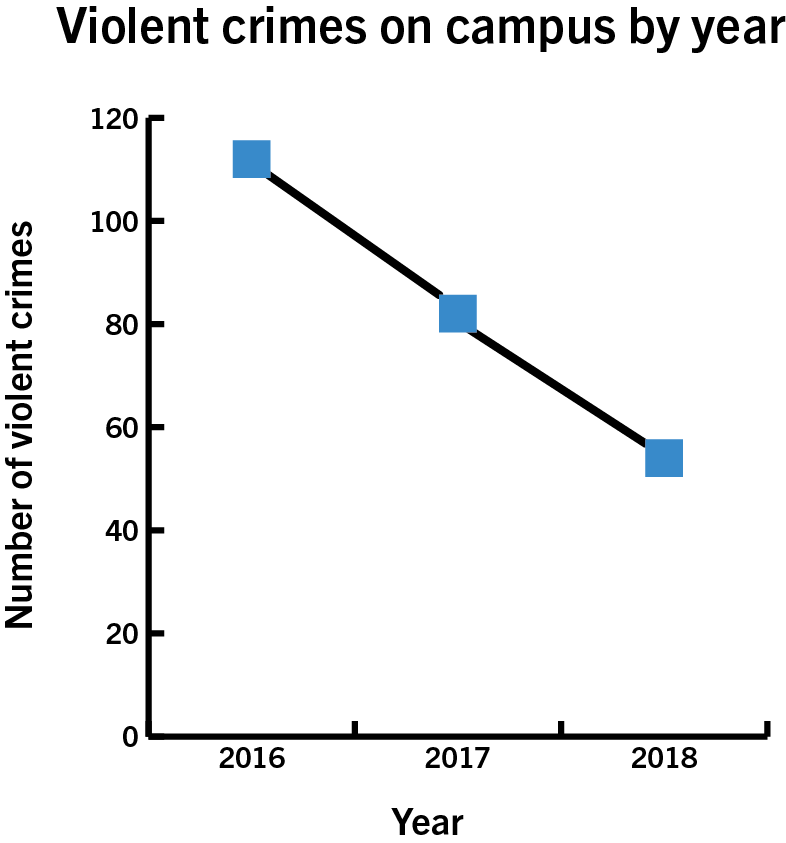Violent crimes on campus have dropped by nearly half in the past three years, according to the 2018 Annual Security and Fire Safety Report released earlier this month.
In 2018, 54 violent crimes – which include rape, robbery, aggravated assault, domestic violence and dating violence – occurred on the Foggy Bottom and Mount Vernon campuses, a 51 percent decrease from the 112 violent crimes that occurred on the two campuses in 2016, according to the report. Criminal justice experts said a drop in violent crimes on campus could be consistent with the downward trend in D.C.-wide violent crimes.
The safety and security report is published each year in compliance with the Clery Act, which requires colleges and universities to disclose crime statistics on and around their campuses. The Clery Act categorizes murder and non-negligent manslaughter, robbery, aggravated assault, domestic violence, dating violence and rape as violent crimes.
Interim GW Police Department Chief Mary Paradis said finding an exact reason for a decrease in a certain type of crime is difficult, but GWPD responds to all crime with equal rigor. Officers respond to the scene, determine whether the victim needs medical services, contact the Metropolitan Police Department if needed, take a report and investigate the crime.
“GWPD works in close collaboration with MPD and the consortium of universities in the D.C. area to track crime trends, provide police presence and harden the physical security of buildings and residence halls,” Paradis said.

Alyssa Illaria | Graphics Editor
Source: 2018 Annual GW Fire and Security Report
She said students can be conscious of their surroundings and keep track of their belongings to curb on-campus violent crimes. Officials will add electronic locks to every student’s residence hall room beginning next calendar year to boost student security.
Paradis declined to say how GW’s policy for responding to violent crimes changed in the past few years.
GW logged the highest violent crime rate of any D.C. university – with a total of 112 and 82 violent crimes on the Foggy Bottom and Mount Vernon campuses in 2016 and 2017, respectively – according to the safety and security report. Howard University had the second highest violent crime rate for both years, with 60 in 2016 and 31 in 2017, according to the school’s annual safety and security report.
Harold Pollack, the co-founder of the University of Chicago Crime Lab and a professor at the School of Social Service Administration, said a strong Title IX program could deter crimes like dating violence, which are exacerbated when alcohol is involved.
“One of the crimes that we’re most concerned about with students is dating violence, and many of these crimes that involve students are alcohol-related,” Pollack said.
Ann Pauley, the vice president for institutional advancement and media relations at Trinity Washington University, said the university’s campus safety patrol, security camera network and tap access into residence halls curb violent crime on campus. No violent crimes have occurred at Trinity Washington in the past three years, according to its safety and security report.
“Safety is a high priority for all of the D.C. campuses,” Pauley said. “We are in an urban environment, and so we all need to take extra steps.”
Trinity Washington teaches about 1,500 students – nearly 10,000 fewer than GW – and is located in a residential neighborhood in an enclosed campus. Pauley said Trinity Washington officials alert students of crimes that happen near campus and on campus because students frequently spend time in surrounding neighborhoods.
“We have very limited entrances, and there are only two entrances to the campus that are staffed and monitored by our campus safety staff,” she said.
Theodore Baran, the director of public safety at Gallaudet University, located in the Trinidad neighborhood in Southeast D.C., said teaching students to be aware of their surroundings and personal safety can deter violent crimes.
“We get kids from all over rural areas, and they come to D.C. and they’re overwhelmed with this, so suggesting the kids stay in packs and walk together and work in pairs, and then just being mindful,” Baran said.
Seventy-five violent crimes occurred on Gallaudet’s campus in 2016 – while 50 and 51 occurred in 2017 and 2018, respectively – according to the school’s annual safety and security report.
Baran said upticks and downturns in campus crime normally reflect crime trends in the neighborhoods in which universities are located.
Violent crimes District-wide have dropped about 30 percent since 2016, according to MPD data. Violent crimes in the Second District, in which GW is located, have decreased by about 20 percent since 2016, according to data from MPD.
“Typically, when you see a spike or uptick, that typically will probably be consistent on what you see around D.C.,” Baran said.





